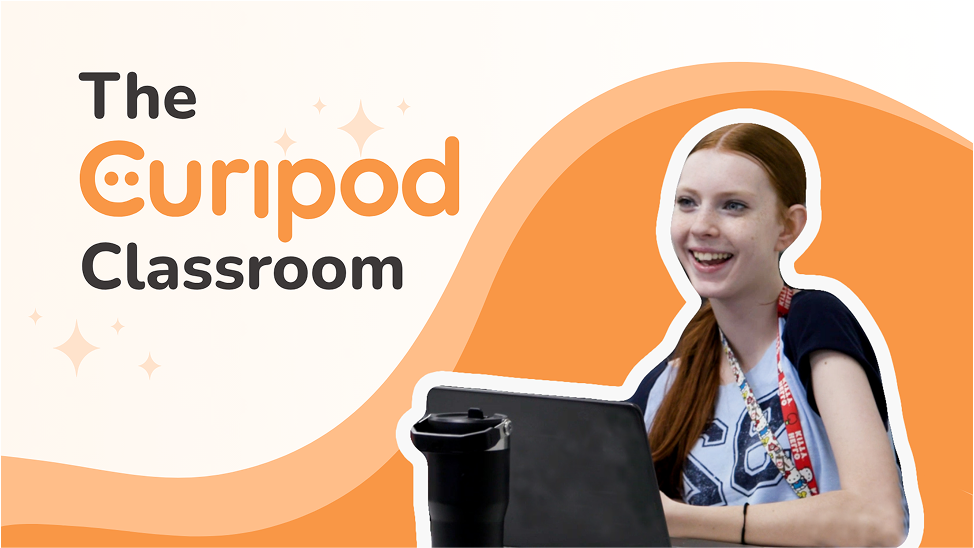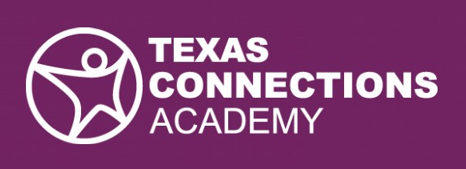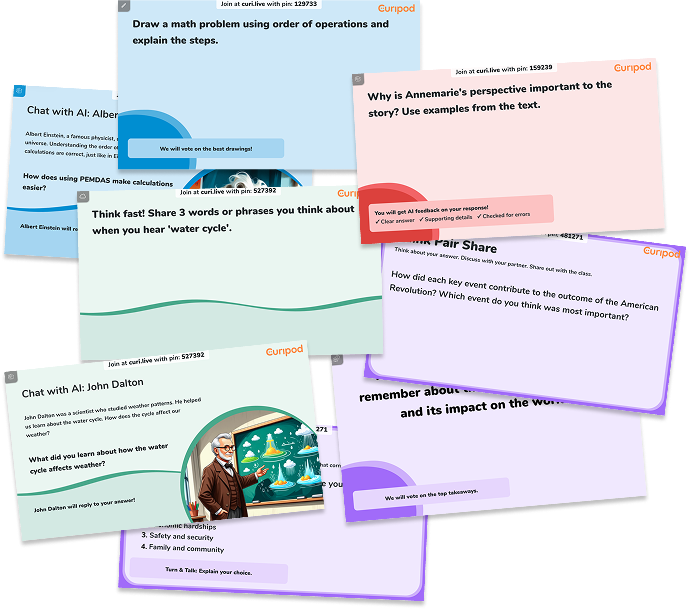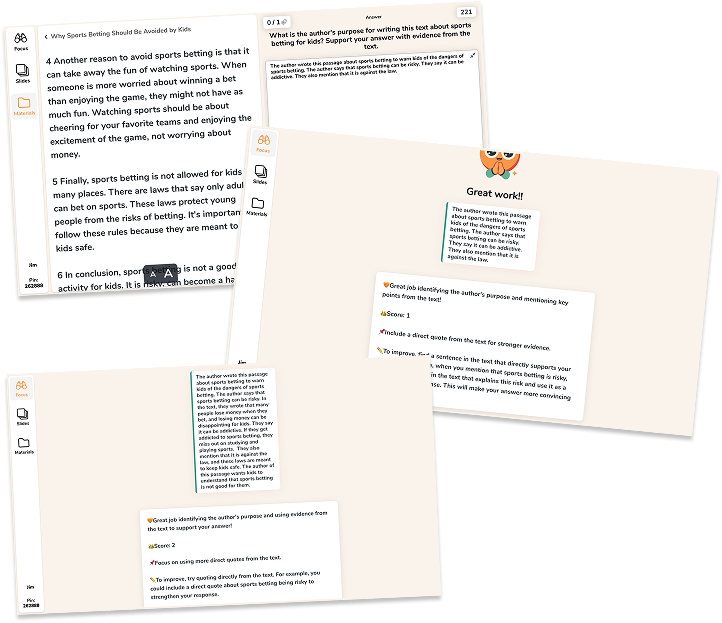
Zaufani w zakresie wysokiej jakości nauczania na całym świecie



























Zachęć uczniów, by oderwali wzrok od ekranów i rozmawiali ze sobą
Lekcje prowadzone przez nauczyciela, wspierane przez AI, zaprojektowane na podstawie badań i najlepszych praktyk dydaktycznych
Uzyskaj wysokiej jakości lekcje dla każdego przedmiotu i na każdym poziomie klasy
Kompletne z slajdami, interaktywnymi aktywnościami i oceną w czasie rzeczywistym od AI dla uczniów—na dowolny temat, w dowolnym języku, zgodne z Twoimi standardami i materiałami dydaktycznymi.
Język angielski (ELA)
Matematyka
Nauki społeczne
Nauki przyrodnicze
Języki obce
Zawodowe i techniczne
Kompetencje społeczne i emocjonalne
I więcej!
Zobacz, dlaczego 12 milionów uczniów z entuzjazmem przychodzi na zajęcia


100% aktywne uczestnictwo, wbudowane
Informacje zwrotne AI w czasie rzeczywistym na każdym etapie
Aktywności Curipod obniżają bariery uczestnictwa. Wszystko, co robią wspaniali nauczyciele, jest wplecione w strukturę każdej lekcji
Uczniowie otrzymują konkretne i praktyczne informacje zwrotne od AI w czasie rzeczywistym, gdy nauka jest jeszcze świeża, co pomaga im reflektować, wprowadzać poprawki i rozwijać się
Od chwil w klasie do trwałego wpływu

Na Curipodzie uczniowie z entuzjazmem piszą, otrzymują zgodną z rubryką informację zwrotną od AI, reflektują i dokonują poprawek w czasie rzeczywistym—budując gotowe do testów umiejętności i pewność siebie
Przeczytaj nasze studia przypadku wpływu, aby dowiedzieć się więcej
Co mówią nauczyciele?
Uczniowie uwielbiają korzystać z Curipoda, ponieważ zawsze otrzymują jakąś informację zwrotną. Niezależnie od tego, czy to ja w narzędziu monitorującym nauczyciela, czy rówieśnicy przeglądający i głosujący na ich odpowiedzi, czy AI udzielające wskazówek do poprawy, Curipod wzbudza naturalną chęć, by każdy uczeń dał z siebie absolutnie wszystko.

Claudia Garcia, nauczycielka ELAR
Uwielbiam to narzędzie do angażowania uczniów! Od krótkich odpowiedzi po rysunki, to narzędzie technologiczne jest na szczycie mojej listy do angażowania uczniów w treści!

Amy Clayton, specjalista ESL
Nawet najbardziej niechętni uczniowie pochylali się do przodu, chcąc pisać. Uczniowie gimnazjum mogą niechętnie brać udział w zajęciach, ale nie z Curipodem! Uwielbiają otrzymywać natychmiastową informację zwrotną od AI z możliwością poprawy.

Becky Canter, nauczycielka ELL w szkole średniej I stopnia
Informacja zwrotna od AI z punktacją do przygotowania do testów jest świetna! Nigdy nie widziałam uczniów bardziej podekscytowanych pisaniem!

J. Tiemann, nauczyciel klasy 4, Medina Valley ISD
Przez ponad 15 lat jako trener technologii nie wiem, czy widziałem platformę, która zyskałaby popularność tak szybko jak Curipod. To był ratunek! Pozwala mi tworzyć talie z treściami i aktywnościami zgodnymi ze standardami w około minutę. Uczniowie są zaangażowani i proszą o więcej!

Karyn Fillhart, Specjalista ds. Technologii Edukacyjnych
Kiedy po raz pierwszy przeprowadziłam Curipoda na swojej lekcji, miałam uczennicę, która odmówiła pracy w parze. Była bardzo nieśmiała. Spróbowała Curipoda sama i po lekcji zwierzyła mi się: „To było naprawdę trudne.” (Mystery Mission). Odpowiedziałam: „Dlatego sugeruję pracę w parze. Co dwie głowy, to nie jedna!” Następnego dnia zrobiliśmy Misję ponownie. Tym razem moja nieśmiała uczennica dobrała się w parę — i pokonała Misję! Promieniała z dumy, gdy jej rozwiązanie zostało wybrane na pierwsze miejsce. Curipod to nie tylko rewolucja w uczeniu się, ale także sposób na budowanie pewności siebie uczniów w ich własny głos!

Użyłam Curipoda, aby przygotować moich piątoklasistów do STAAR z czytania, zwłaszcza do krótkich i rozszerzonych odpowiedzi konstrukcyjnych. Byli wciągnięci od początku — interaktywne podpowiedzi i informacja zwrotna na żywo sprawiły, że chcieli poprawiać i ulepszać. Jeden uczeń powiedział: „Czy możemy robić to codziennie?” Ich pewność siebie rosła z każdym slajdem, a tym razem pisanie było ekscytujące — nie stresujące.

Salo Donson, Nauczyciel dwujęzyczny w 5. klasie, Fort Worth ISD
Jestem nauczycielką z 15-letnim stażem, która do niedawna nie zagłębiała się w technologię na lekcjach, a teraz zachęcam kolegów, by przyszli i zobaczyli Curipod! Oszczędność czasu i poprawa moich materiałów lekcyjnych są namacalne

Aileen Wallace, Nauki społeczne, Graeme High School, Szkocja
Współpracują, tworzą, a co ważniejsze… rozmawiają! Dlatego Curipod trafił mnie prosto w serducho. Wnosi tę samą iskrę do lekcji akademickich. Jest dynamiczny, działa w czasie rzeczywistym i ma jedną magiczną supermoc: sprawia, że moi ósmoklasiści faktycznie mi odpowiadają. (Nie żartuję — czasem myślę, że Curipod to jedyny powód, dla którego zauważają, że istnieję!)

Erika Sandstrom, Nauczycielka Mediów Cyfrowych/Trenerka ds. uczenia cyfrowego, Peabody Public Schools
Curipod spotkał mnie na skrzyżowaniu pilnej potrzeby i innowacji. W zaledwie miesiąc przemienił moich uczniów z niechętnych autorów w pewnych siebie, ciekawych myślicieli. Pisanie stało się czymś, co chcieli robić, a nasze wyniki testów na koniec roku dowiodły siły tej zmiany!

Sequoia Ford, Nauczycielka 3. klasy, Mansfield ISD
To właśnie kocham w Curipod. Dostarcza potężne narzędzia, które pomagają nauczycielom zaspokajać potrzeby ich uczniów. Utrzymuje nauczyciela w obiegu i sprawia, że uczniowie angażują się ze sobą, a nie tylko ze swoim urządzeniem.

Dave Hinrichs, Dyrektor ds. Platform Cyfrowych i Pedagogiki, Johnston County Public Schools
Curipod działa, ponieważ wspiera nauczyciela, nie próbując go zastąpić… Pomaga nauczycielom i uczniom nawiązać więź, pozwala nauczycielowi poznać tok myślenia swoich uczniów oraz zapewnić informację zwrotną wystarczająco wcześnie, aby uczniowie — i nauczyciele — mogli dokonać zwrotu.

Karyn Fillhart, Specjalistka ds. Technologii Edukacyjnych, Chino Valley Unified School District
Uwielbiam, jak Curipod odwraca narrację, koncentrując się na uczeniu jako społecznym, wspólnym doświadczeniu, w którym liczy się głos każdego ucznia. Curipod to nie tylko kolejne narzędzie cyfrowe — to platforma, która stawia społeczność, ciekawość i krytyczne myślenie w centrum procesu uczenia się.

Salo Donson, Nauczyciel dwujęzyczny w 5. klasie, Fort Worth ISD
Zgodne ze standardami i ocenami stanowymi
Bezpieczne i zgodne (zgodne z FERPA i COPPA)
Lekcje tworzone przez nauczycieli — nie wymagają kont uczniów
Przemyślana integracja AI
Lekcje zaprojektowane przez edukatorów dowiedz się więcej o naszych zasadach nauki tutaj